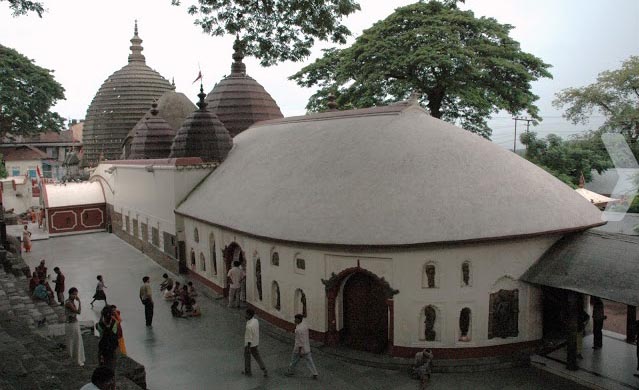Kamakhya Temple

Information of Kamakhya Temple, Guwahati, Kamrup, Assam
The Kamakhya Temple is considered to be one of the most powerful Hindu temples. It is located on Nilachal Hill of Guwahati city in Assam. The temple is dedicated to Goddess Kamakhya in her ten different forms. It is one of the 108 Sakti peeths present in India that is different areas where parts of Devi Shaktis body had fallen. Kamakhya is the Goddess of love. Kama is a Sanskrit word for love making and is said that this is where Lord Shiva and Devi Shakti showed their love. It is also a famous tantric temple.
Kamakhya Temple Religious Importance
The temple remains open from 5:30 am till 10 pm for tourists and pilgrims. On special occasions like the Durga Puja the timing is extended but a routine is followed. The sacred bath is performed at 5:30 in the morning, the temple opens for devotes at 8 in the morning, at 1 in the afternoon the temple is closed to offer cooked food and is also distributed among the devotees, the temple reopens at 2:30 followed by aarti at 5:30 in the evening.
The temple is closed in the month of June for three days as a sign of bleeding, The main festival celebrated is the Durga Puja usually in the month of October and also the Ambubachi Mela drawing a large number of pilgrims for tantric worship.
Kamakhya Temple Mythology & History
According to the myths it is said that the Death of Devi Shakti maddened Shiva to such an extent that he carried her dead body at his back and began wandering. The Shakti's body started decomposing and began falling in different parts. The Kamakhya is where her womb and vagina fell there and a temple has been built in the name in the name of the Devi Shakti, which is popular with the name Kamakhya Temple.
This temple is also referred to as the temple of the bleeding Goddess. In the month of June people witness the change of colour of the adjoining part of the River Brahmaputra to red. It is said that the Goddess is undergoing menstrual cycle.
It is said that the clan of Kamakhya survived till end of 7th century. A few evidences show that the temple was built before the 7th century but flourished during the Kamarupa Kings who were strong followers of tantrikism and had become a famous centre of Tantrik religion. During the 10th century BC Buddhism had found its way in the abode.
The temple was later destroyed by Kamata invasion in 1498 but was restored by the heir of the Koch dynasty, Naranarayana in 1565. The temple was further destroyed but again restored by the ruler of Ahom dynasty from the remains of the old temple as a Hindu temple of the Shakti.
Kamakhya Temple Architectural Importance
The Kamakhya temple is built with medieval Assam style building mainly indicating the Nagara style. There are a total of six temples in which ten different forms of Shakti is installed.
The Garbhagriha is the main sanctum of the temple in which the three forms of the Devi is worshipped Tripura sundari, Matangi and Kamala. The Garbhagriha ia a cave like place where the deity is worshipped. No form of idol is placed there but instead a vulva shaped hole on the rock is worshipped as the goddess which is filled with spring water all the time. The Sikhara that is the dome like structure at the top of the temple is bee-hive shape and is surrounded by a group of smaller ones.
There are three other chambers the calanta to the west, pancharatna to the west of chalanta and natamandira further west of pancharatna. Each houses idols of different forms of Goddess Kamakhya. Figures of Narayana is carved on the walls of the chalanta. The panchratna as the name implies pancha meaning five has five small shikharas. The natamandira had a ridged roof and had carvings of the Singhas who built it. Thus from architectural point of view, it has rustic outlook, but apart from that it is well organised and well planned, which makes convenient for devotees to offer prayer and to attend the major festival celebrate here.
- Andhra Pradesh Temples
- Assam Temples
- Bihar Temples
- New Delhi Temples
- Goa Temples
- Gujarat Temples
- Jammu and Kashmir Temples
- Karnataka Temples
- Kerala Temples
- Madhya Pradesh Temples
- Maharashtra Temples
- Odisha Temples
- Punjab Temples
- Rajasthan Temples
- Sikkim Temples
- Tamil Nadu Temples
- Telangana Temples
- Uttar Pradesh Temples
- Uttarakhand Temples
- West Bengal Temples